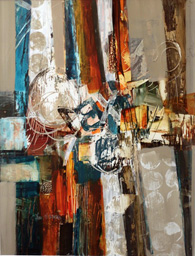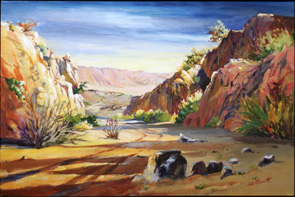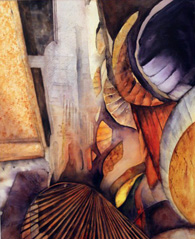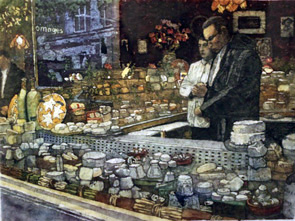Over 100 paintings in 2011 Fall Exhibition
NorthStar Watercolor Society hosted a reception and opening of its fall show, “All About Color,” at Century College on November 3 from 6:30 – 9 p.m. The show had 103 entries this year according to Leny Wendel, co-chair for the event. The reception included a wonderful buffet of treats thanks to Dar Bunde and Linda Paduano. The Juror, Neil Johnston, spoke about his requirements when judging a show. There was a prepared statement available for all attendees which included his list of key ideas: Impression, Composition, Color, Technical Merit, Color Movement, and Subject Matter and its relationship to the materials. Professor Johnston commented that he walks through initially and looks at all the paintings, then returns to the ones he remembers, looking at them from across the room. He then takes photos so that he can see them in a different scale on his camera.
Honorable Mention
He awarded seven Honorable Mentions to the following artists (awards are in alphabetical order per category, i.e. all awards in a category are considered “equal” in merit):
 Calvin deRuyter: “Grey Skies” (image left) Comments: Immediacy of brush work; confidence in large composition; playfulness of horizon line, no indecision in this painting.
Calvin deRuyter: “Grey Skies” (image left) Comments: Immediacy of brush work; confidence in large composition; playfulness of horizon line, no indecision in this painting.
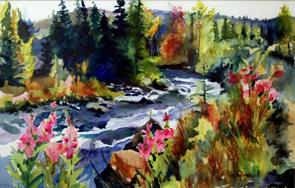 Polly Olmstead: “Alaska River” (image right) Comments: Suggested imagery draws the viewer in; symbolic nature of brush strokes with water tumbling through; crisp atmosphere; hints of a few rocks – everything spins the viewer up and away.
Polly Olmstead: “Alaska River” (image right) Comments: Suggested imagery draws the viewer in; symbolic nature of brush strokes with water tumbling through; crisp atmosphere; hints of a few rocks – everything spins the viewer up and away.
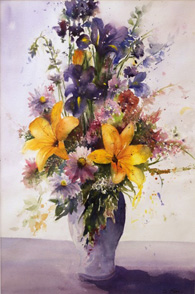
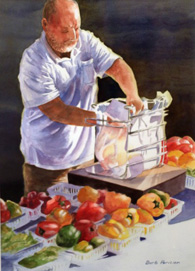 Sue Olson: “Summer Glory” (image far right) Comments: Not “putzed” over; piece just falls into place; all parts flow into each other; complex color balances with subtle changes in color; flowing shadow changes; small brush strokes contrast with large ones.
Sue Olson: “Summer Glory” (image far right) Comments: Not “putzed” over; piece just falls into place; all parts flow into each other; complex color balances with subtle changes in color; flowing shadow changes; small brush strokes contrast with large ones.
Barb Parisien: “Morning Market 2” (image center right) Comments: Narrative is pretty clear; story keeps the viewer engaged; internal colors tumble through the painting all the way up to the darker background; those colors cycle through and around again; tells a story with the color progressions.
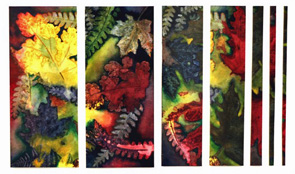 Laura Shepler: “Follow Your Heart” (image near right) Comments: Multiple panel painting is collaged with larger objects in larger spaces progressing to smaller items in much smaller panels; repetition, variety and unity hold the piece together; colors go from brightest and biggest to fade-out.
Laura Shepler: “Follow Your Heart” (image near right) Comments: Multiple panel painting is collaged with larger objects in larger spaces progressing to smaller items in much smaller panels; repetition, variety and unity hold the piece together; colors go from brightest and biggest to fade-out.
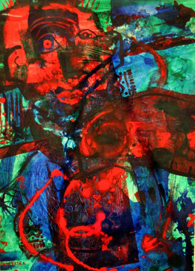 Ann Sisel: “Norbert (Bright Northman)” (image left) Comments: Power and immediacy in this painting with the bright red and blue images – warm and cold; dynamic movement in the abstract figure; painting techniques not automatic which makes this a dynamic composition; strength and power of the face of Northman helps balance the colors.
Ann Sisel: “Norbert (Bright Northman)” (image left) Comments: Power and immediacy in this painting with the bright red and blue images – warm and cold; dynamic movement in the abstract figure; painting techniques not automatic which makes this a dynamic composition; strength and power of the face of Northman helps balance the colors.
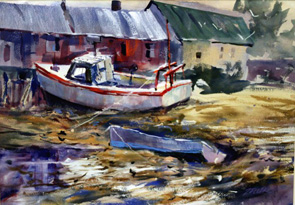 Frank Zeller: “Dry Dock” (image left) Comments: Captured the weight of the boat at the dock; the composition flows; very subtle upper right corner; there is an immediacy of effort and no “putzing” around; mastery of the subject, shapes and composition.
Frank Zeller: “Dry Dock” (image left) Comments: Captured the weight of the boat at the dock; the composition flows; very subtle upper right corner; there is an immediacy of effort and no “putzing” around; mastery of the subject, shapes and composition.
Awards of Merit:
Nels Femrite: “Cat Canyon” (image near right) Comments: A very traveled pathway takes one from side to side, back to the mountain and back to the front with colors – smooth transition; moves one through effortlessly; composition is master!
Lana Grow: “Central Dialogue” (image far right) Comments: Color and composition hold this painting together; lots of marks and scratches and possibly print-making techniques make interesting visual markers; round circles are playful; repetition of marks have a relationship to each other, hold it all together, talk to each other.

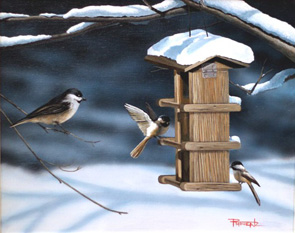 Randall Raduenz: “Busy Bodies” (image near left) Comments: Photographic realism focusing on the images shows technical craft; close-up details of the birds’ feet and legs show strokes almost like an abstract; up close like a mosaic.
Randall Raduenz: “Busy Bodies” (image near left) Comments: Photographic realism focusing on the images shows technical craft; close-up details of the birds’ feet and legs show strokes almost like an abstract; up close like a mosaic.
Carolyn Wensman: “Bottles” (image far left) Comments: Shapes of the bottles flow together; keeps the viewer engaged by building image out of shapes, negative space supports the positive space; simple brush strokes allow room for the viewer to fill in; everything fits like a puzzle; holds together abstractly but also figuratively.
Awards of Excellence:
Rebecca Cardinal: “The Cheese Shop” (image near right) Comments: Very intricate batik painting with lots of subjects; a difficult process; details applied at different times; unity and variety of so many shapes hold the painting together; perspective, scale, and texture follow the shapes and colors; amber glows radiant and luminous; very well made in the batik process; there is a micro/macro sense about it.
Carol Wold: “Lost Echoes” (image far right) Comments: Drawn to the composition, color and scale of the abstract; radiating patterns; looking down in parts but still looking up; challenging dynamics keep interest with immediacy, color, shapes, and textures; causes a reaction to the complex composition and spectral movement.
 Best of Show:
Best of Show:
Jan Vaughan: “Organic Abstract” Comments: This painting contained all the elements on the list of required elements; there is immediacy with the color application and collage of materials; little surprises all over; ink and paint and colors with large shapes, rocks hold or frame the entire smaller universe inside; a micro and macro experience; technical intricacies; the art transcends its making and goes beyond the making; the artist gets out of the way.
Statement on Judging
By Neil Johnston My process for the selection of awards for this show is based on several key areas: Impression: This is an attempt to acknowledge my immediate reaction to a piece. Did the piece first grab my attention? Usually, this is the first step in deciding finalists in a competition. Composition: This is a measure of how the elements within a composition work to create the visual experience. How well is the image put together? Do all the parts work together? Is there a dominant series of movements? Color: How well is the color in an image managed? This is not a measure of bright, colorfulness, but of how an artist purposefully finesses the color choices in the work. Technical Merit: Is a sense of how the image is actually crafted. This has nothing to do with style, more with how an artist carefully or purposefully applies the materials to a specific end. Often t his appears as spontaneous-ness or deliberateness. Color Movement: This is a measure of the complexity and the use of color balance. Does the color transition as my eye travels across the image? This quality shows a level of expertise in color selection, use and creation. Subject matter and its relationship to the materials: Do the above qualities, materials selection and the subject depicted, work together to express a consistent theme, idea or emotion? The jurying process is an arduous and sometimes emotional one. I strive to consider the strengths of each piece, working through the key areas (above) to make the very difficult decision. It needs to be said that a juried competition is not merely placing awards on the work that exemplifies some pre-determined ‘rules’ of excellence. The process is often about inviting a juror to make decisions based on his or her individual aesthetic sensibilities. Every juror will pick a selection of work that quite possibly will be different than another juror’s. This underscores and supports the wonderful variety and artistic diversity present in each individual work, and within each of us as active viewers and appreciators of this wonderful art form.
 2011 Fall Exhibition judge: Neil Johnston
2011 Fall Exhibition judge: Neil Johnston
By Leny Wendel Exhibition judge Neil Johnston, holds a Bachelor of Fine Arts in painting from the College of Visual Arts in Saint Paul, Minnesota, and a Master of Fine Arts Visual Studies in painting from the Minneapolis College of Art and Design in Minneapolis, Minnesota. 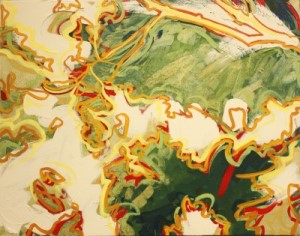 Neil has been commissioned by private collectors and corporations for many paintings and local murals. His work (image right) is collected by local patrons such as Medtronic Inc., Hines International, and recent collaborative work in the Century College Library. Neil teaches Painting 1, Painting 2, Drawing 1, 2D Design, Art History of the Western World 1, and Art History of the Western World 2 at Century College and is a long-time board member of the White Bear Center for the Arts. Neil Johnston’s work has often combined images, textures and other visual remnants from multiple viewpoints and places. In this new work, Johnston is especially interested in the ambiguity found in the map-like quality of tree leaf canopy patterns. These patterns are in one; a pattern gathered from a specific location and a pattern that suggests randomness or non-specificity. His work process involves traveling to various points in the landscape, capturing a photograph of a tree leaf pattern, documenting the GPS coordinates, and logging any meteorological data and personal thoughts. The seemingly ambiguous abstract qualities of the tree leaf patterns disguise the very specific nature of the paintings; these are patterns taken from very specific points in very specific locations with specific narratives. Johnston is currently inspired by the works of Sigmar Polke, Ingred Calame, Franz Ackermann, Arturo Herrera, Takashi Murakami, and Julie Mehretu.
Neil has been commissioned by private collectors and corporations for many paintings and local murals. His work (image right) is collected by local patrons such as Medtronic Inc., Hines International, and recent collaborative work in the Century College Library. Neil teaches Painting 1, Painting 2, Drawing 1, 2D Design, Art History of the Western World 1, and Art History of the Western World 2 at Century College and is a long-time board member of the White Bear Center for the Arts. Neil Johnston’s work has often combined images, textures and other visual remnants from multiple viewpoints and places. In this new work, Johnston is especially interested in the ambiguity found in the map-like quality of tree leaf canopy patterns. These patterns are in one; a pattern gathered from a specific location and a pattern that suggests randomness or non-specificity. His work process involves traveling to various points in the landscape, capturing a photograph of a tree leaf pattern, documenting the GPS coordinates, and logging any meteorological data and personal thoughts. The seemingly ambiguous abstract qualities of the tree leaf patterns disguise the very specific nature of the paintings; these are patterns taken from very specific points in very specific locations with specific narratives. Johnston is currently inspired by the works of Sigmar Polke, Ingred Calame, Franz Ackermann, Arturo Herrera, Takashi Murakami, and Julie Mehretu.

